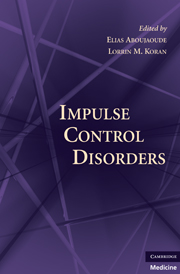Book contents
- Impulse Control Disorders
- Impulse Control Disorders
- Copyright page
- Dedication
- Contents
- Contributors
- Acknowledgments
- Introduction
- Section I Acquisitive Impulses
- Section II Pellicular Impulses
- Section III Information-Seeking Impulses
- 15 Problematic Internet Use: Clinical Aspects
- 16 Virtual Violence: The Games People Play
- 17 Counseling in Cyberspace: Your E-Therapist Is on Call
- Section IV Sexual and Aggressive Impulses
- Appendix I: Treatment Guidelines
- Appendix II: List of Scales and Assessment Instruments
- Index
15 - Problematic Internet Use: Clinical Aspects
from Section III - Information-Seeking Impulses
Published online by Cambridge University Press: 06 July 2010
- Impulse Control Disorders
- Impulse Control Disorders
- Copyright page
- Dedication
- Contents
- Contributors
- Acknowledgments
- Introduction
- Section I Acquisitive Impulses
- Section II Pellicular Impulses
- Section III Information-Seeking Impulses
- 15 Problematic Internet Use: Clinical Aspects
- 16 Virtual Violence: The Games People Play
- 17 Counseling in Cyberspace: Your E-Therapist Is on Call
- Section IV Sexual and Aggressive Impulses
- Appendix I: Treatment Guidelines
- Appendix II: List of Scales and Assessment Instruments
- Index
Summary
Keywords
- Type
- Chapter
- Information
- Impulse Control Disorders , pp. 167 - 181Publisher: Cambridge University PressPrint publication year: 2010
- 7
- Cited by

